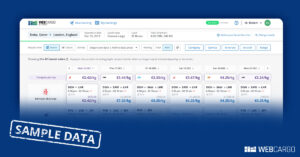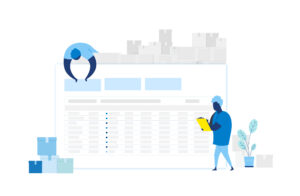Freight Quoting Tools For Forwarders: What Are They & How To Use Them

What is a freight quoting tool?
Freight quoting tools help forwarders leverage static freight rates that are managed from a range of carriers, combine them with dynamic, real-time market rates, include origin or destination changes, markups and surcharges, and use these to build accurate, market-relevant customer quotes with optimized routing and pricing.
Shippers are increasingly looking to make more informed – and faster – decisions. Providing more optionality for increased visibility, speed, and efficiency of freight quoting has therefore become a necessity for forwarders looking to gain an edge in customer acquisition and retention. So has leveraging real-time market rates and capacity from carriers. Forwarders are therefore increasingly turning to freight quoting tools to meet these more sophisticated expectations.
Watch David Wystrach, Global Head of Airfreight at Scan logistics, explain how forwarder expectations have changed in 2023…all in under 4 minutes
How Freight Forwarders use freight quoting tools
Over the last decade, instant freight quoting tools, when paired with rate management systems, have upgraded how forwarders quote, providing an edge to help them win business in an increasingly volatile market and competitive landscape. These typically relied on manual rate sheets – in Excel or even plain-text format – that weren’t always in-line with market rates or available capacity. Of course, the gap between available capacity, market rates and static rate sheets expanded dramatically during the volatility of the freight markets in 2020 and 2022.
While standard freight quoting tools only offer the comparison of static rates, broader freight quoting tools leverage the rampant digitization of carrier-supply over the last few
A critical transition period
Remember: As long as rates are not linked to real-time visibility of capacity, bookings are not linked to actual space, meaning the final price and timeline remain uncertain. Given that the market has not yet shifted over to fully digitized rates, though, the industry is currently in an hybrid period where both static rates and dynamic rates must live side-by-side. Therefore, a broader freight quoting tool that provides both static and dynamic rates is crucial to ensuring a final price and timeline on specific carriers.
Navigating the transition with ease
You wouldn’t use a golf cart to traverse sand dunes – you need an off road 4×4!
A comprehensive freight quoting tool is vital for navigating market volatility during this transition period and keeping forwarders ahead of the curve. Here’s why in 10 words: Allowing forwarders to compare static and dynamic rates isn’t enough.
A comprehensive freight quoting tool provides information to forwarders on all parts critical to winning business: the myriad of pricing and routing details required for efficient and accurate quote-building – not just information on rates.
And WebCargo’s industry-leading freight quoting tool does just that.
Top 6 features of WebCargo’s freight quoting tool
- Comparison of static airline rates (with guaranteed data accuracy)
Freight rate data accuracy is paramount. Before putting any rates live for forwarders to compare, the WebCargo system scans the file used for uploading rates, to ensure there are no errors or columns showing incorrect information. If an error is found, it is made easily identifiable and the account executive can then access the file and make any necessary changes. This multi-layered approach to rate-upload ensures that the rates being uploaded are correct, and that any mistakes do not result in costly time-input for forwarders to fix.
- Provision of the rate upload date and validity dates
People look for expiration dates on food items, so why not for carrier rates? After a rate search across static rates, WebCargo provides information about the rate upload date and validity in the search results, as well as allowing users to see when the rate was last updated. This added layer of immediate rate-transparency enables forwarders to provide an improved customer experience. Customers benefit from quicker quote-building, thanks to the time reduction in obtaining the latest data compared to via the use of traditional phone-email loops.
- Addition of surcharges
No more manual entry of surcharges that invites human error. For import rates, surcharges can be added to the rate upload sheet. For exports, there are permanent surcharges added to the system and automatically uploaded for forwarders. Manually needing to add surcharges to freight quotes can see data retyped dozens of times for a single shipment, inviting human error to slow the process. By automatically building surcharges into quotes, WebCargo’s freight quoting tool improves data accuracy and reduces the time and costs needed to address errors inherent in the manual quoting process.
- Access to both static and dynamic rates
Fresh fish or frozen? In the era of information, where customers are looking to obtain the latest pricing wherever possible, WebCargo’s dynamic quoting feature allows forwarders to meet those expectations by sharing live capacity rates with customers. Dynamic rates linked to real-time capacity produce rates that lead to real-time quotes and ultimately instant booking confirmations, making a forwarder’s quoting (and booking) process far more efficient.
- Creation of multi-currency, localized and branded quotations
When using WebCargo’s static rate quoting feature, forwarders are able to include multiple currencies in their quotations. Freight forwarders often deal with customer quotations in different countries, requiring the ability to take and offer payments in different currencies. When creating a quote using the static rate tool on WebCargo,
- Multimodal quoting
WebCargo’s AcceleRate is a multimodal, door to door quoting tool which also includes CRM and business analytics for freight forwarders. AcceleRate offers data accuracy with automated contract and spot rate visibility, as well as direct rates and supplied tariffs from real-time carrier pricing APIs with carriers such as Vanguard, Maersk, ONE, and more. With AcceleRate’s door-to-door quoting, forwarders can generate quotes with instant landed costs, integrated directly with their TMS and CRM systems. The time saved with such instant rate search and quotation building can increase team efficiency by as much as 86%.
How Air Cargo quoting tools impact the bottom line
For forwarders, having a powerful freight quoting tool behind them is vital for reducing the cost of human error, as well as increasing the speed and reliability of quote-building. This ultimately reduces the time forwarders need to spend on building routine quotes, freeing them to address more complex cases, and other value adding behaviors which further improve the customer experience.

